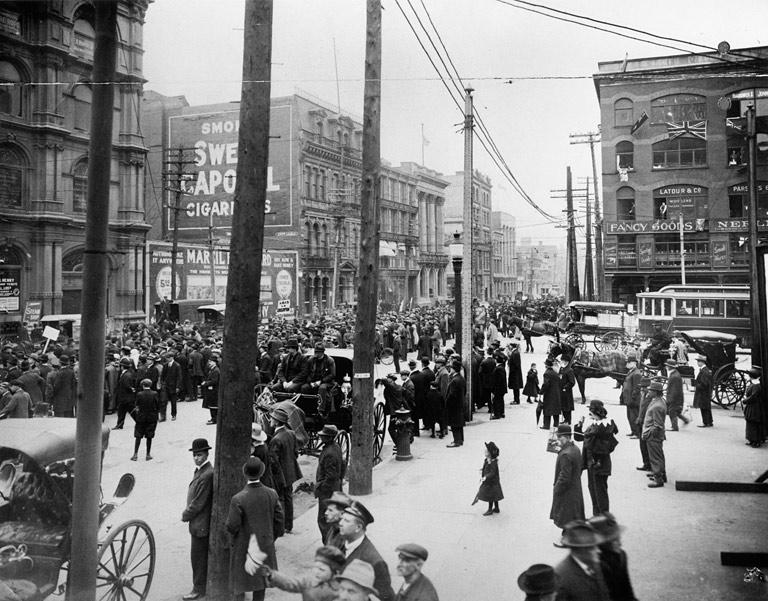
World War I: Canada--Conscription Debate

Figure 1.--This is downtown city square 'park' in Montreal--Victoria Park. Anti-conscription French Canadians are staging a protest parade (May 1917). The Square was chosen by the protestors because it was created to honor Queen Victoria and still has a statue of her there today. Most of those here in the streets are anti-conscription protestors, but you can see hanging on a building a Union Jack flag meaning that store owners were pro-conscription, meaning pro-British. Whether they were pro- or anti-Canadian was a part of the debate. Ironically, the French Canadians protesting the conscription bill felt no connection with France or inclination to save France from the Germans. Source: Militaryhistoryofthe20thcentury.com.
|
|
Pressure for conscription to build this army grew. Prime Minister Robert Borden spoke out and insisted that conscription was a military necessity (1917). German successes on the Eastern Front made it clear that the Germans would have substantial forces to deploy on the Western front that could resolve the War in 1918. British officials appealed for more help from the Dominions. Borden saw the military necessity and he also wanted to strengthen Canada's voice within the Empire. Borden crossed the Atlantic to see the situation of the Canadian troops in France. The ensuing debate was one of the most empasioned and divisive political issue in Canadian history. There was considerable opposition. The French-Canadians in particular were opposed. There wera a range of issues that French Canadians had with the Anglo-dominated Federal Government. And this all fed into the conscription debate. Ironically the fight to save France from the Germans aroused little sympathy among French Canadians. There was also opposition from farmers, many of whom were of German ancestry. Not only did they not want to fight the Germans, but ther was considerble pacifist feeling. Avoiding conscription and Prussian militarism were some of the reasons their ancestors had left Germany in the first place. The same phenomenon was observeable in the American Midwest to the south which also had a striong German population. The American Midwest would also be the hard core of Ameican isolationism during the opening phase of World War II--until Pearl Harbor. There was also opposition from unionized workers and non-British immigrants. Support came from English-speaking Canadians, British immigrants, the families of soldiers, and older Canadians. The debate evolved into bitter charges on boh sides. The opponents were accused of disloyalty, cowardice, and immorality. The supporters were accused of imperialism, stupidity, war-mongering, and bloodlust.
CIH

Navigate the CIH Woirld War I Pages:
[Return to Main Canadin conscription page]
[Return to Main Canadian World War I page]
[Return to Main World War I conscription page]
[Return to Main World War I people page]
[Return to Main Candian conscription page]
[Aftermath]
[Alliances]
[Animals]
[Armistace]
[Biographies]
[Causes]
[Campaigns]
[Casualties]
[Children]
[Countries]
[Declaration of war]
[Deciding factors]
-------[Diplomacy]
[Economics]
-------[Geo-political crisis]
[Home front]
[Intelligence]
[Military forces]
[Neutrality]
[Pacifism]
[People]
[Peace treaties]
[Propaganda]
[POWs]
[Russian Revolution]
[Signals and intelligence]
[Terrorism]
[Trench warfare]
------[Technology]
------[Weaponry]
[Bibliographies]
[Contributions]
[FAQs]
[Images]
[Links]
[Registration]
[Tools]
[Return to Main World War I page]
[Return to Main war essay page]
[Return to CIH Home page]
Created: 2:00 AM 5/28/2014
Last updated: 2:00 AM 5/28/2014



